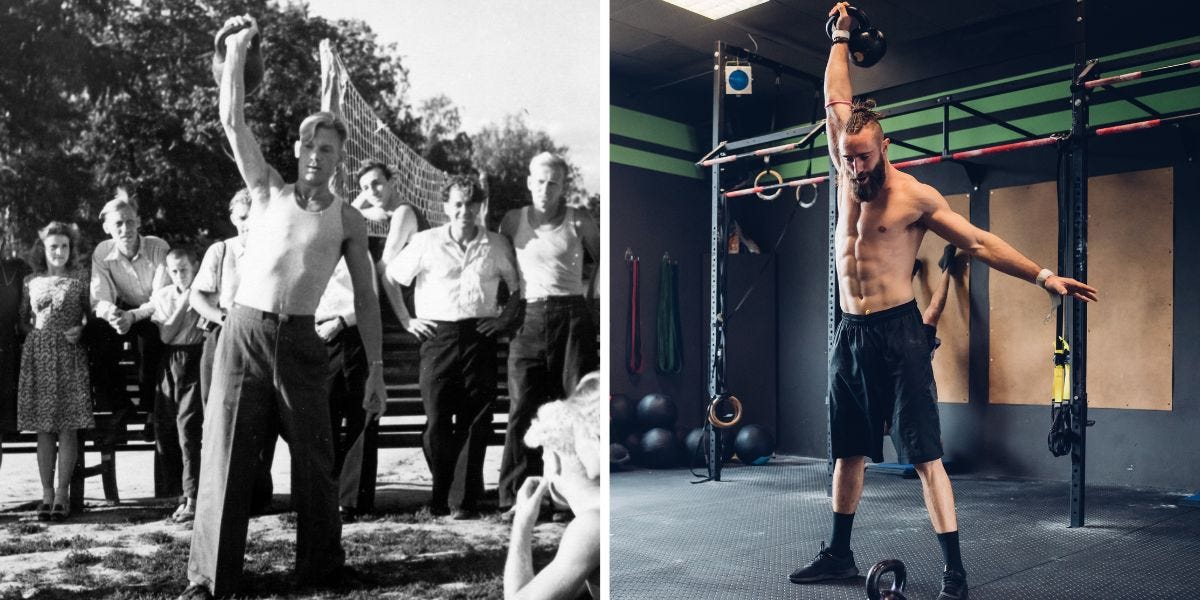During the Cold War, Soviet scientists and coaches developed a demanding and highly effective system of training for their elite special forces, Olympic wrestlers and national athletes. The science-based training methods they pioneered, from high-rep calisthenics to explosive kettlebell drills and plyometrics, continue to influence training to this day.
‘The Soviets didn’t train for aesthetics. They trained for war,’ says hybrid athlete and author James Pieratt of Wild Hunt Conditioning. The methods included some of history’s most disciplined and scientifically informed approaches to human performance.
However, one important caveat: while the Soviet system was undeniably effective, it’s worth noting that state-sponsored doping was also a documented part of their elite sports programmes – a reminder that even the most scientific methods can exist in ethically murky waters.
Spetznaz soldiers
‘Spetsnaz were elite soldiers forged through extreme physical and psychological preparation,’ explains Pieratt. ‘Their training combined brutal field drills with cutting-edge Soviet sports science. Every session had one goal: create warriors who could survive, dominate, and endure behind enemy lines.’
Pieratt says their methods predated modern ‘functional training’ by decades. ‘Spetsnaz also trained under extreme psychological stress: blindfolded drills, sleep deprivation, freezing weather and live-fire movement exercises. Pain tolerance wasn’t a bonus, it was mandatory.’
Soviet sports scientists like Verkhoshansky and Medvedyev revolutionised periodisation, plyometrics, and fatigue management, explains Pieratt. ‘These weren’t gym guys with clipboards. They were state-funded performance engineers for a military empire.’
Srdjanns74//Getty Images
Kettlebell training
When taking a look at the 1970s- and ’80s-era special forces personnel from the Soviet Union, their training is just as advanced, as precise and as well-balanced as any athlete today, and the protocols wouldn’t look out of place in a modern day strength and conditioning programme.
‘They were doing all the stuff you would expect: overhead presses, Turkish get-ups, kettlebell swings, farmers carries,’ says Pieratt. ‘But they were also doing some pretty interesting stuff.’ He continues to explain that they completed something called a triple extension throw: ‘A kettlebell swing where you use all the power in your body to let the bell continue all the way up over your head and you throw it back behind you. It’s like the perfect full-body explosive movement.’
They had all the modern equipment necessary, however they were still out in freezing temperatures lifting stones and carrying logs. ‘That is strongman-style training, that’s mental grit,’ says Pieratt.
Calisthenics
Pieratt says that bodyweight training is excellent at making you ‘immune to the effects of lactic acid’, making it a staple for martial artists, a runners, or any athletes. He explains that if you don’t like the sensation when your muscles start burning, ‘Get more calisthenics in your life: high-volume, high-intensity calisthenics.’
‘Most of the time what gets you in combat is endurance, Pieratt adds. ‘You get fatigued before there’s any shortage of a singular force output. So calisthenics have always been a big part of the Soviet system.’
Plyometric Training
Yuri Verhoshansky was a pioneer of plyometric training. Pieratt explains this is where depth drop training – where you start on a higher box, jump down to the ground and as soon as you impact, you hop into another leap – started appearing. You may have seen football players and hybrid athletes alike take part in this method.
‘Training like this made guys really powerful, really explosive. Soviet track and field athletes – there’s archival footage showing how springy and explosive some of these guys were.’
Spatial Awareness Training
Soviet paratroopers focused on acrobat training including trampoline jumps, synchronised flips and group acrobatics. ‘It taught them not only to be aware of their own bodies in space but also to calculate and observe in the midst of movement – a kind of physical-spatial intelligence,’ says Pieratt.
Combat Martial Arts
Combat Sambo is a Russian martial art that combines different techniques. Pieratt adds, ‘It’s essentially a mix of Russian wrestling, striking, and Japanese judo – and when you train them really hard for a long time, you get amazing skill sets.’
However, it wasn’t for the faint of heart, according to Pieratt they weren’t doing the sport version, they were gouging eyes, striking throats and training for life or death on the battlefield. Needless to say, not a method to be tried at home.
Related Stories

